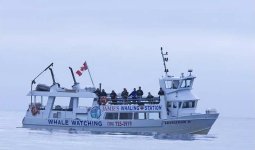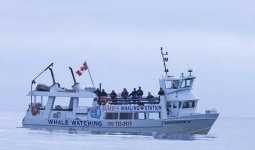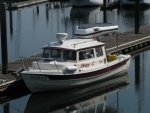chromer":3pcm9j7i said:
Do they really need to sell liquor on a whale tour? You never know what kind of crowd shows up on these things. I really dont understand why everyone would be crowding around on top deck to see a seal, otter or something like it
Seal and sea lion viewing is popular on our wildlife trips. I have guests specifically ask if we will see them. Stellar Sea Lions especially, because of their size; seals because "they are so cute." The opportunity to see whales is the big draw, but there is a great variety of wildlife that many people have never seen in the wild. The captains will trade information if there is a puffin or a river otter to be seen. Each trip is a unique opportunity.
The company I drive for does not allow alcohol on any public trip. If a party charters the boat, they can purchase a Washington State beverage license so they can have alcohol onboard. It is still up to the captain and crew to maintain safety - on private charters I do make mention of the increased effects of alcohol when on the water. I do not know the regulations regarding this subject in Canada.
On US Coast Guard inspected boats, stability tests determine the number of passengers allowed. Those tests include moving the estimated weight of "passengers" around the boat. Out on the water, I see some boats that heel more than others under the weight of all the passengers on one side.
Seeing the photos of the Leviathan II, it looks like the worst stability situation would be all the passengers aboard on that higher middle deck. Pure speculation, but had the guests been distributed around the boat, it would have helped offset the weight "aloft. It would seem (to me) that more guests (more than the 24 they were carrying), so that there would be some lower and distributed fore and aft, would be more stable. In a stability test, it would be near impossible to anticipate
a half load of guests, all on the highest deck, and an undetected large wave from the other side.
There was one day this summer where all the boats out of Friday Harbor canceled trips - horrible wind. Earlier, there was one trip where we couldn't get to the whales because of nasty conditions where Haro Strait and Juan de Fuca come together. The forecast was for 2 to 3' waves; we were experiencing 5 to 6' waves and worsening conditions. We had two boats out there, and we both made the decision to get back inside (into more protected water) where conditions were better. In nasty conditions, you are on high alert... when conditions are more benign, you have to not let yourself get lulled into not keeping your guard up. (sorry for the double negative)
Anyone who has spent time on the water has had those "Where did that come from??" moments. Even at anchor. Might be unanticipated wake from a passing ship, confused wave patterns coming together, higher than normal tides making for stronger than normal current, a whale surfacing close, debris in the water (really tough to see in close wave conditions), a boat coming up behind you, rapidly changing weather. Closer to shore, you tend to be more "aware," but you simply can't let your guard down.
The difference between driving your own boat and driving an excursion boat are marked. Schedules, expectations, and responsibility... some guests come onboard completely unprepared clothing-wise (even though they were given good information in writing), expecting the trip to be like a Disney ride. It isn't. I am often told, "You have the best job ever," and it can be pretty spectacular; it is also a lot of work and responsibility.
Imagine what the owner and crew of Leviathan II must be going through. The families of those who were lost. The thought of this makes my heart ache.
Try as you might, this situation drives home the fact that the unexpected can happen. Being able to see the wildlife is something that some might take for granted. Most boat crews that I know take the responsibility very serious, and look forward to introducing people to seeing wildlife in their natural habitat; educating the public about the wildlife; hoping that each guest gets to take home a new understanding and some great memories. All in a safe and respectful manner.
My heart sank when I first heard this news. Days later, it is still hard to see/hear it discussed, often by people who just don't understand what can happen on the water. The Pacific Whale Watch community has a fine safety record - hopefully we can learn from this... not just commercial operators, but all those who spend time on the water.
Jim




